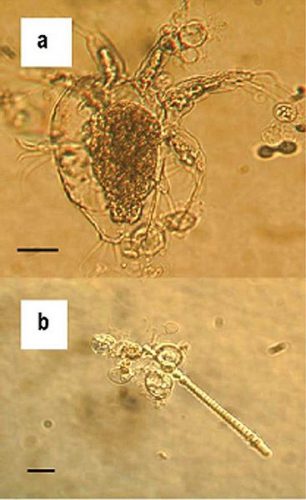Image courtesy of Wikipedia
Globalized trade has spread diseases to all corners of the world, causing various disruptions to ecosystems. One pathogen in particular, called Batrachochytrium dendrobatidis (Bd), is thought to be one of the deadliest wildlife fungi. Discovered in 1987, it infects amphibians through the skin and often proves to be fatal. In Latin America, forests that used to be teeming with amphibians are now relatively quiet.
Prior research had only ever documented the presence or absence of the Bd pathogen within given regions of the globe. However, no studies had analyzed the genomes of these fungi. Professor Erica Rosenblum and a team of researchers at the University of California, Berkeley sought to use genome sequencing to identify different lineages of the fungus and locations where lineages cross over to create new strains. The team also hoped to map out the evolutionary history of the pathogen, allowing them to assess how the disease may spread in the future.
Rosenblum and others used a unique method to characterize each Bd DNA sample. “It doesn’t require any destructive sampling,” Rosenblum said. The method only requires a small swab from the skin of an amphibian. After sequencing the entire genomes of a few samples of pathogen, they picked parts of the genome that were useful for identification, deciding on around 200 positions on a particular chromosome. From here, they developed an assay to test the genetic composition of these various loci quickly and cost-effectively.
For decades, scientists from all over the world have been collecting Q-tips of DNA samples to determine the presence of the Bd fungus. Many of these samples have been sitting idly in freezers. Using the technique developed by Rosenblum’s lab , these older samples can be used to piece together the story of how the pathogen originally spread. “We can go back in time and look at when, let’s say, this lineage first arrived in Brazil,” Rosenblum said.
After their analysis, the research team categorized the pathogen strains based on geographic location: Asia, Europe, Africa and the Americas. Significantly, they found a new type of lineage of the fungus in Asia. This finding further supports the hypothesis that the disease has Asian origins.
Further studies should focus on creating a more comprehensive map of Bd lineages, using even more DNA samples of the Bd pathogen. There are still many instances where researchers know that the Bd pathogen is present, but the exact lineage is unknown. With the new method that the team used in this study, older Bd samples are available for analysis. Thus, another avenue for future research is understanding the timeline of each Bd fungi lineage. “I am most excited about using museum samples to go back and really reconstruct what happened, going back hundreds and hundreds of years,” Rosenblum said. Understanding when Bd appeared in relation to the decline in amphibians will be important for future analysis and predictions.
Given the growing range of the Bd pathogen, Rosenblum thinks it is important to monitor and limit its spread. From the food industry or the pet industry, the shipment of animals is a big part of global trade. This makes checking for diseases before transport especially important, according to Rosenblum.
The spread of the Bd pathogen has important implications. They threaten the fragile biodiversity of ecosystems through their decimation of amphibians, who sit right in the middle of the food chain. They regulate insect population and act as food for other predators. An imbalance in an ecosystem can have a butterfly effect, eventually hurting human health and agriculture.

